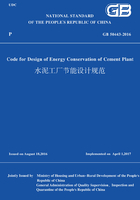
2.2 Building
2.2.1 Buildings of the cement plant shall be classified according to their purposes,functions and energysaving requirements,and shall be in accordance with the following requirements:
1 In the plant,the Office Building,Central Control Room,Laboratory,individual offices for workshops,Complex Building and public buildings such as the Dining Room,Bath House and Guard Room shall be classified as Class A.
2 In the plant,the residential buildings such as the staff dormitory shall be classified as Class B.
3 Production buildings with heating or air conditioning,and auxiliary buildings with low temperature heating such as individual substations,Water Pumping Station,Water Treatment Room,Compressed Air Station,Garage,Service Shop etc.,shall be classified as Class C.
4 Auxiliary industrial buildings requiring heating or air conditioning such as Duty Room,Checkout Room,Control Room inside the workshops without heating or air conditioning shall be classified as class D.
2.2.2 The open size of external windows of Class C and D buildings of a cement plant located in nonheating regions should be enlarged for natural ventilation.Mechanical ventilation facilities shall be installed if openable casements cannot be adopted.
2.2.3 A porch or other measures shall be adopted for Class C buildings in severe cold regions so as to prevent cold air.
2.2.4 External windows of Class C and D buildings in severe cold and cold regions may be selected according to those specified in Table 2.2.4.The Air permeability level of external windows shall not be lower than the Level 3 specified in the current national standard GB/T 7107 Graduation and Test Method for Air Permeability Performance of Windows.The same air permeability requirements are applicable to external doors and the thermal conductivity of door panels shall not be below 1.5W/m2·K.
Table 2.2.4 Windows of Class C and D buildings in severe cold and cold regions

2.2.5 The energy efficient design of Class A buildings shall meet the relevant requirements of the current national standard GB 50189 Design Standard for Energy Efficiency in Public Buildings.When the Shape Coefficient of small single-story public buildings in the simplest shape is above 0.4,limit of thermal conductivity of roof and external walls may be increased by 5% of original value.
2.2.6 The energy efficient design of Class B buildings shall be carried out on the basis of their location and climate and be in respective compliance with the current professional standards JGJ 75 Design Standard for Energy Efficiency of Residential Buildings in Hot Summer and Warm Winter Zone,JGJ134 Design Standard for Energy Efficiency of Residential Buildings in Hot Summer and Cold Winter Zone and JGJ 26 Design Standard for Energy Efficiency of Residential Buildings in Severe Cold and Cold Zones.
2.2.7 As to the energy efficient design of Class C buildings,the minimum thermal resistance of their roof and external walls may be determined according to the current national standard GB 50176 Thermal Design Code for Civil Building as well as indoor and outdoor temperature.If external walls require thermal insulation,exterior thermal insulation measures for external walls should be adopted.
2.2.8 The energy efficient design of Class D buildings may comply with the current national standard GB 50176 Thermal Design Code for Civil Building.The minimum thermal resistance of external walls may be determined by the indoor and outdoor temperature.The interior thermal insulation for internal walls shall be adopted at the same time.The exterior surface of partition walls of the rooms with heating inside the nonheating workshops shall adopt exterior thermal insulation measures for external walls.
2.2.9 Glass curtain walls should not be applied to any buildings of the cement plant.